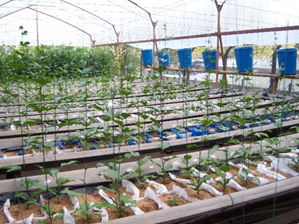Especies promisorias de Passiflora L. (Passifloraceae) por su tolerancia al estrés hídrico-salino

Resumen
El objetivo de este estudio fue determinar la tolerancia al estrés hídrico y salino en cuatro especies cultivadas de Passiflora L. Se evaluaron 11 accesiones de cuatro especies de Passiflora de interés comercial provenientes de diferentes plantaciones. El diseño experimental fue en parcelas subdivididas, donde la parcela principal fue el porcentaje de saturación de agua en relación con los requisitos del cultivo (33 y 100%). La subparcela se estableció por los niveles de saturación de sal (cloruro de sodio nivel reactivo – 99,9% de pureza) (CE: 1.50 y 5.5 dS m-1) con 11 accesiones en una disposición completamente aleatoria, con cinco repeticiones, donde la unidad experimental fue una planta. Los resultados mostraron que las accesiones m11, m13 (P. edulis f. flavicarpa) y m15 (P. tarminiana) se consideraron tolerantes a la salinidad y la sequía; las accesiones m2 (P. edulis f. edulis), m12 y m14 (P. edulis f. flavicarpa) fueron moderadamente tolerantes. Estas observaciones son la base para futuros estudios de tolerancia a la sequía en Passiflora, que deben ser seguidos por evaluaciones de campo.
Palabras clave
Passiflora spp., Estrés abiótico, Peso seco, Recursos genéticos, Fisiología del estrés
Citas
Agronet. 2019. Estadísticas agropecuarias. In: Ministerio de Agricultura y Desarrollo Rural de Colombia, https://www.agronet.gov.co/estadistica/Paginas/home.aspx?cod=1; consulted: August, 2019.
Cavalcante, L.F. (ed.). 2012. O maracujazeiro amarelo e a salinidade da agua. Sal da Terra, João Pessoa, Brazil.
Fageria, N.K., W. Soares, and H.R. Gheyi. 2010. Melhoramento genético vegetal e seleção de cultivares tolerantes a salinidade, pp. 212-225. In: Gheyi, H.R., N. Diasand, and C.F. Lacerda (eds.) Manejo da salinidade na agricultura: Estudos básicos e aplicados. Instituto Nacional de Ciência e Tecnologia em Salinidade “INCTSal”, Fortaleza, Brazil.
Fan, J., J. Meng, Y. Ashkenazy, S. Havlin, and H.J. Schellnhuber. 2017. Network analysis reveals strongly localized impacts of El Niño. Proc. Natl. Acad. Sci. U.S.A 114, 7543-7548. Doi: 10.1073/pnas.1701214114
FAO. 2020. Versión resumida de El estado mundial de la agricultura y la alimentación. Superar los desafios relacionados con el agua en la agricultura. Roma. Doi: 10.4060/cb1441es
Gomes, M.T.G., A.C. Luz, M.G. Santos, M. Batitucci, D.M. Silva, and A.R. Falquetoa. 2012. Drought tolerance of passion fruit plants assessed by the OJIP chlorophyll a fluorescence transient. Sci. Hortic. 142, 49-56. Doi: 10.1016/j.scienta.2012.04.026
Hurtado-Salazar, A., D.F.P. da Silva, N. Ceballos-Aguirre, J.A. Ocampo, and C.H. Bruckner. 2017. Proline and ions accumulation in four Passiflora species under water-saline stress. Comun. Sci. 8(4), 570-580. Doi: 10.14295/cs.v8i4.2323
Hurtado-Salazar, A., D.F.P. da Silva, N. Ceballos-Aguirre, J.A. Ocampo, and C.H. Bruckner. 2018. Salinity tolerance of Passiflora tarminiana Coppens & Barney. Rev. Colomb. Cienc. Hortic. 12(1), 11-19. Doi: 10.17584/rcch.2018v12i1.7335
Jehová, L.J., Z. Oberdan, R.M. Santos, and C.G. Faustini. 2013. Effects that nutritional and saline gradients have on the growth of Passiflora mucronata Lam. and Canavalia rosea (Sw.) DC. found in the restinga of Brazil. Acta Bot. Bras. 27(2), 318-326. Doi: 10.1590/S0102-33062013000200008
Niu, F., D. Zhang, Z. Li, M. Van Iersel, and P. Alemb. 2015. Morphological response of eucalypts seedlings to phosphorus supply through hydroponic system. Sci. Hortic. 194, 295-303. Doi: 10.1016/j.scienta.2015.08.029
Ocampo, J., R. Urrea, K. Wyckhuys, and M. Salazar. 2013. Exploración de la variabilidad genética del maracuyá (Passiflora edulis f. flavicarpa Degener) como base para un programa de fitomejoramiento en Colombia. Acta Agron. 62(4), 352-360.
Ocampo, J., J.C. Arias, and R. Urrea. 2016. Interspecific hybridization between cultivated and wild species of genus Passiflora L. Euphytica 209(2), 395-408. Doi: 10.1007/s10681-016-1647-9
Rodríguez, N.C., L.M. Melgarejo, and M.W. Blair. 2019. Purple passion fruit, Passiflora edulis Sims f. edulis, variability for photosynthetic and physiological adaptation in contrasting environments. Agronomy 9(5), 231. Doi: 10.3390/agronomy9050231
Silveira, J.A., S. Silva, and R.A. Viegas. 2010. Mecanismos biomoleculares envolvidos com a resistência ao estresse salino em plantas. pp. 205-218. In: Gheyi, H.R., N. Diasand, and C.F. Lacerda (eds.). Manejo da salinidade na agricultura: estudos básicos e aplicados. Instituto Nacional de Ciência e Tecnologia em Salinidade “INCTSal”, Fortaleza, Brazil.
Statistical Analysis System. 2013. SAS User ́s guide v 9.4 (CD-ROM). SAS Institute, Cary, NC.
Yertayeva, Z., R. Kizilkaya, S. Kaldybayev, N. Seitkali, N. Abdraimova, and A. Zhamangarayeva. 2019. Changes in biological soil quality indicators under saline soil condition after amelioration with alfalfa (Medicago sativa L.) cultivation in meadow Solonchak. Eurasian J. Soil Sci. 8(3), 189-195. Doi: 10.18393/ejss.552563
